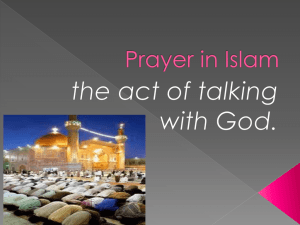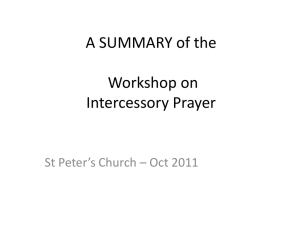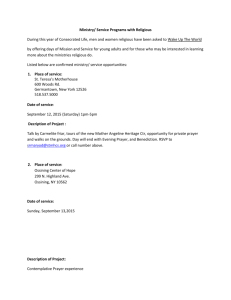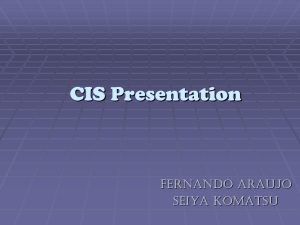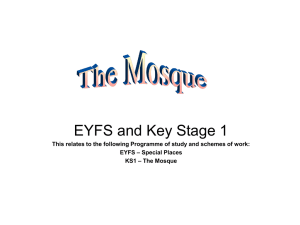Focus - Redbridge RE Network
advertisement
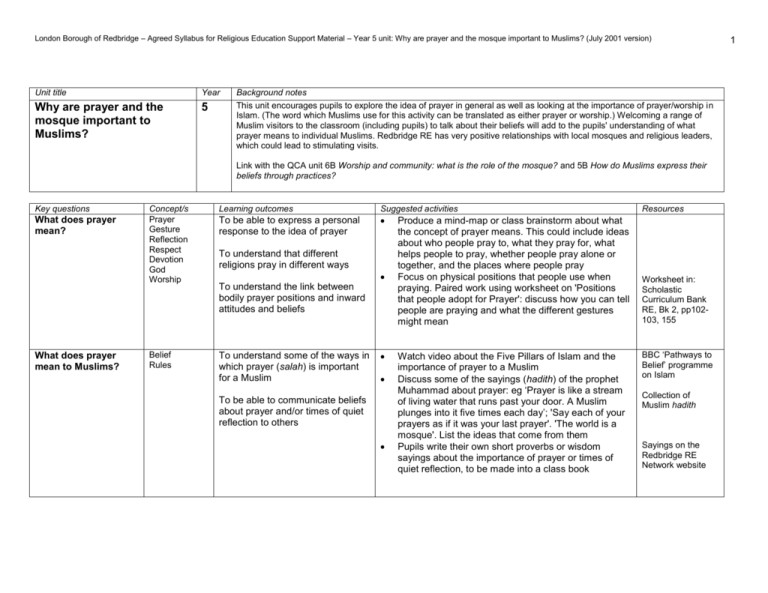
London Borough of Redbridge – Agreed Syllabus for Religious Education Support Material – Year 5 unit: Why are prayer and the mosque important to Muslims? (July 2001 version) Unit title Year Why are prayer and the mosque important to Muslims? 5 Background notes This unit encourages pupils to explore the idea of prayer in general as well as looking at the importance of prayer/worship in Islam. (The word which Muslims use for this activity can be translated as either prayer or worship.) Welcoming a range of Muslim visitors to the classroom (including pupils) to talk about their beliefs will add to the pupils' understanding of what prayer means to individual Muslims. Redbridge RE has very positive relationships with local mosques and religious leaders, which could lead to stimulating visits. Link with the QCA unit 6B Worship and community: what is the role of the mosque? and 5B How do Muslims express their beliefs through practices? Key questions What does prayer mean? What does prayer mean to Muslims? Concept/s Prayer Gesture Reflection Respect Devotion God Worship Learning outcomes Suggested activities To be able to express a personal response to the idea of prayer Belief Rules To understand some of the ways in which prayer (salah) is important for a Muslim To understand that different religions pray in different ways To understand the link between bodily prayer positions and inward attitudes and beliefs To be able to communicate beliefs about prayer and/or times of quiet reflection to others Produce a mind-map or class brainstorm about what the concept of prayer means. This could include ideas about who people pray to, what they pray for, what helps people to pray, whether people pray alone or together, and the places where people pray Focus on physical positions that people use when praying. Paired work using worksheet on 'Positions that people adopt for Prayer': discuss how you can tell people are praying and what the different gestures might mean Watch video about the Five Pillars of Islam and the importance of prayer to a Muslim Discuss some of the sayings (hadith) of the prophet Muhammad about prayer: eg ‘Prayer is like a stream of living water that runs past your door. A Muslim plunges into it five times each day’; 'Say each of your prayers as if it was your last prayer'. 'The world is a mosque'. List the ideas that come from them Pupils write their own short proverbs or wisdom sayings about the importance of prayer or times of quiet reflection, to be made into a class book Resources Worksheet in: Scholastic Curriculum Bank RE, Bk 2, pp102103, 155 BBC ‘Pathways to Belief’ programme on Islam Collection of Muslim hadith Sayings on the Redbridge RE Network website 1 London Borough of Redbridge – Agreed Syllabus for Religious Education Support Material – Year 5 unit: Why are prayer and the mosque important to Muslims? (July 2001 version) What helps Muslims to pray? Lifestyle Community Belonging Preparation To respond sensitively to religious artefacts from the Muslim tradition To understand why preparation for prayer/worship is important to a Muslim What are the main features of a mosque? Special places Mosque Design To understand some of the key features associated with the mosque To know the purpose of these key features Look at a collection of Muslim religious artefacts, such as a prayer mat, prayer beads (tasbih), qibla compass, topee, headscarf and share knowledge of what they are and how they might be used Carefully observe the prayer mat and share what you can see on it eg image of a mosque, the Ka'bah, the alcove representing the direction of Makkah, Arabesque patterns around the edge. Discuss how a prayer mat is used and how a qibla compass might be used to find the direction of Makkah. Design a prayer mat that uses some of the special features discussed Looking at pictures, sections from a video, or a Muslim visitor, talk about the importance of washing before prayer (wudu), the significance of removing footwear to pray and the different prayer positions. Look at a diagram that shows daily times of prayer Using a writing frame, write about the different important aspects of Muslim prayer and decorate with pictures of Muslims at prayer or arabesque designs BBC ‘Pathways to Belief ‘video on Islam Look at different pictures of mosques and see if there are any similarities or differences, such as the dome and minaret. Pupils could investigate the appearance of mosques around the world using ICT Move to the internal appearance of the mosque. Using sheet on 'Simplified ground plan of the Mosque', talk about each area and its significance for what happens there Link together the information and pictures on the worksheet 'The features of a Muslim Mosque' and use this as a basis for writing about 'Why the Mosque is built as it is'. Prepare for a visit to a mosque and produce follow-up work, based on the features of the mosque and reflections on the experience of the visit Recordings of the Call to Prayer Artefacts: prayer mat, topee, qibla compass, prayer beads Scholastic Curriculum Bank RE, Bk 1, pp94-95; Bk 2, pp85-87 Pictures of Muslims at prayer, the Ka’bah Muslim prayer times Visitor/s Worksheets in Scholastic Curriculum Bank RE, Bk 2, pp85-87 Pictures of mosques, resource books about Islam 2 London Borough of Redbridge – Agreed Syllabus for Religious Education Support Material – Year 5 unit: Why are prayer and the mosque important to Muslims? (July 2001 version) What does a mosque mean to the Muslim community? Belonging Lifestyle Community To be able to express what community means to them To understand that a mosque is not only a place of prayer for Muslims Discuss what it might mean to be part of a school community. What other communities do they belong to? What special benefits come from being part of a community? Link this with the way that the mosque works within the community: as a place of worship, Islamic school for children, community centre, symbol Plan some questions for a Muslim visitor about why the mosque is important for the Muslim community Muslim visitor/s Glossary of Religious and cultural terms used in this planning grid Arabesque Hadith Hadeeth Ka’bah Kaaba Minaret Mosque Qur’an Qibla Qibla compass Salah Tasbih Topee Wudu Wuzu Symmetrical patterning which is a feature of much Islamic design. Traditionally, Muslims have not shown living forms in art work as this would feel like trying to take the place of Allah (God) as Creator. Islamic art is famous for both Arabesque and calligraphy (often words from the Qur’an). Pronounced had-eeth. Literally ‘a report’. The hadith are a collection of reports about what the prophet Muhammad said or did. They are important in that what Muhammad said or did has been taken as a guide as to how to live a proper Muslim life. The physical positions that Muslims adopt during prayer/worship are based on what Muhammad himself did, as recorded in hadith. The cube-shaped building in the centre of the courtyard of the Great Mosque in Makkah, Saudi Arabia. It is said to be built over the spot where Allah (God) was first worshipped. All Muslims face towards the Ka’bah during worship. The tower attached to a mosque from which, traditionally, the call to prayer could be broadcast to all those nearby. The only mosque with a minaret in Redbridge in the Ilford Islamic Centre and Mosque, Albert Road (see photographs on Redbridge RE Network website).. Arabic – masjid. Muslim place of prayer as well as of other activities such as education. The Holy Book of Islam which Muslims believes contains the words of Allah (God) revealed through the prophet Muhammad. Arabic word for ‘direction’. When Muslims worship, they face in the direction of the Ka’bah in Makkah. When on familiar territory, Muslims will almost certainly know qibla. Mosques are orientated in this direction. But a Muslim traveller, in order to establish the direction to face during worship, might use a special compass with a series of numbers printed next to the magnetic needle. Some prayer mats have a qibla compass sewn into them so that the whole mat is turned when establishing where qibla is. The Arabic word which refers to the prayer/worship which Muslims should perform five times daily. Many Muslims in Britain, because they trace their roots to the Indian subcontinent, will use the Urdu word Namaz. Prayer beads, sometimes referred as Subha in Arabic. A full set will contain 99 beads, a smaller set 33. The beads are loosely threaded so that they can be moved. They are an aid to concentration in private prayer. There are several explanations for their shape and design. A common one is that the 99 beads represent the 99 ‘Wonderful Names ‘ of Allah (God) to be found in the Holy Qur’an. Prayer beads will often be seen hanging on pegs at the side of the worship hall in a mosque. A small cap, often made of white lace-like material, which is worn by Muslim men in some parts of the world. It might be worn all of the time, or only when the person is engaged in devotional activity such as praying or reading the Qur’an . Ritual ablutions performed in readiness for prayer/worship. There is a set way in which this washing takes place. Muslim children will see older people doing this and, if they attend mosque lessons after school, will be taught how to perform wudu and why. 3

